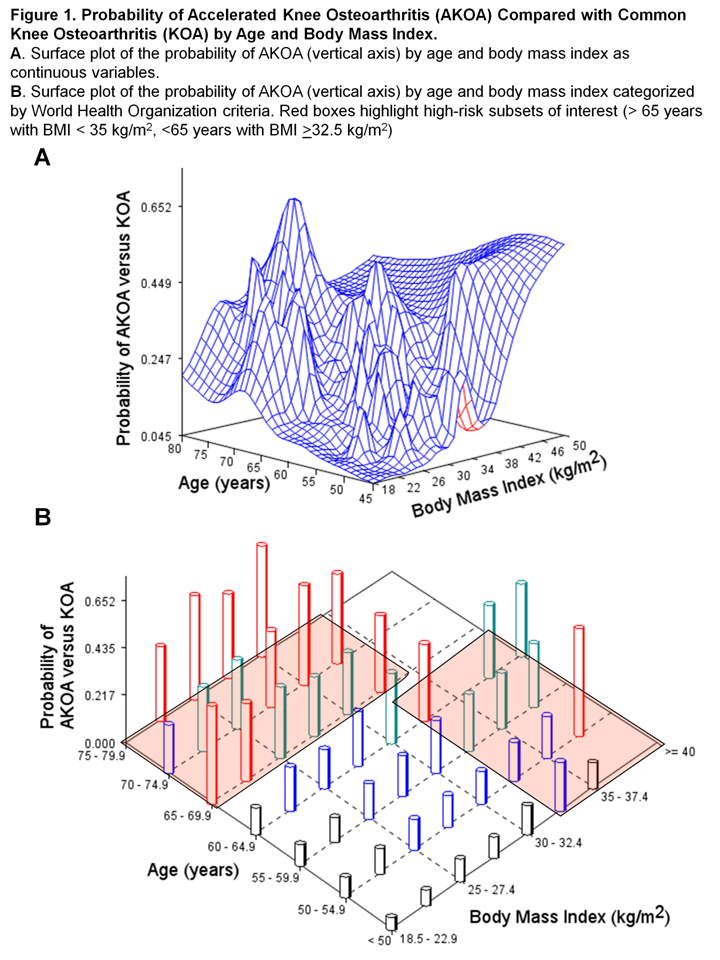Session Information
Date: Sunday, November 8, 2015
Title: Osteoarthritis - Clinical Aspects Poster I: Treatments and Metabolic Risk Factors
Session Type: ACR Poster Session A
Session Time: 9:00AM-11:00AM
Background/Purpose: Accelerated knee osteoarthritis (AKOA) may be a unique subset of knee osteoarthritis (KOA). AKOA is more common among those who are older, overweight, or had a recent knee injury. These three risk factors interact to exacerbate an individual’s risk for AKOA. Identifying which subset of individuals are at most risk for AKOA will help clinicians recognize patients that need more frequent follow-up visits to ensure early detection of AKOA. Therefore, we explored age and body mass index (BMI) to identify a subset of individuals who are at high risk for AKOA compared with common KOA.
Methods: In the Osteoarthritis Initiative we studied participants without KOA on their baseline radiographs (Kellgren-Lawrence [KL] < 2). We compared 2 groups: 1) AKOA: > 1 knee progressed to end-stage KOA (KL Grade 3 or 4) within 48 months and 2) common KOA: > 1 knee increased in radiographic scoring within 48 months (excluding those with AKOA). Age and BMI were collected at the baseline visit. A recent knee injury was a self-reported injury within a year prior to a knee meeting the definition of AKOA or common KOA. We reviewed 3-dimensional surface and contour graphs with age, BMI, and probability of AKOA versus KOA on the axes to identify groups that have the highest probability of AKOA compared with common KOA (see Figure). After we identified two possible subsets as high risk we conducted a logistic regression with AKOA as the outcome and age-BMI groups as the predictor (adjusting for sex and recent knee injury). We also explored stratified analyses among those with and without a recent knee injury.
Results: Among 1,637 participants, 52 (3.2%) individuals had AKOA and 184 (11.2%) had common KOA. We identified two high-risk sets of individuals (Figure 1B): 1) individuals > 65 years of age with BMI < 35kg/m2 (n = 64, 27%) and 2) individuals < 65 years of age with BMI > 32.5 kg/m2 (n = 43, 18%). We defined all other participants as low risk. Overall, older individuals with a BMI < 35kg/m2 were 3.5 times more likely to develop AKOA instead of common KOA than individuals at low risk (see Table). In contrast, younger individuals with a BMI > 32.5 kg/m2were not statistically more likely to develop AKOA instead of common KOA. These findings were consistent among those with and without a recent knee injury (see Table).
Conclusion: While older age and greater BMI are associated with AKOA we found that older individuals with a BMI < 35kg/m2were more likely to develop AKOA than common KOA. Individuals with these characteristics who also report knee pain should be carefully monitored to detect early signs of AKOA.
To cite this abstract in AMA style:
Driban J, Lo GH, Eaton CB, Price LL, Lu B, Barbe M, McAlindon TE. Older Adults without Extreme Obesity Are at Highest Risk for Accelerated Knee Osteoarthritis [abstract]. Arthritis Rheumatol. 2015; 67 (suppl 10). https://acrabstracts.org/abstract/older-adults-without-extreme-obesity-are-at-highest-risk-for-accelerated-knee-osteoarthritis/. Accessed .« Back to 2015 ACR/ARHP Annual Meeting
ACR Meeting Abstracts - https://acrabstracts.org/abstract/older-adults-without-extreme-obesity-are-at-highest-risk-for-accelerated-knee-osteoarthritis/


